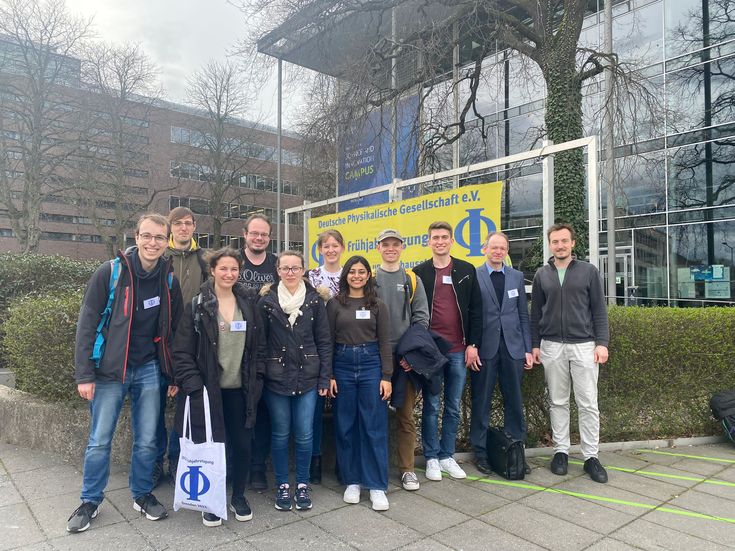DPG Frühjahrstagung Dresden 2023
27.03.2023

AG Biebel at the DPG Dresden. Not on the picture: G. Duckeck and G. Di Paoli
On the 20th of March 2023 the annual Spring Meeting of the DPG (Deutsche Physikalische Gesellschaft) restarted in person after a 3 year online-only break.
After a fun and surprisingly non-delayed train ride together with our fellow particle scientists of AG Kuhr we arrived in Dresden in the evening on the 19th of March. This gave us enough time to explore the historic part of Dresden with all its monuments and attractions like the Frauenkirche, the Zwinger or the Semperoper. Another part of our group used the free time on the arrival day engaging in sportive activities and went bouldering.
Starting from 8 am on the 20th everybody participated in every Germans favorite activity, waiting in a queue for completing the registration and receiving our conference badges. This was organized very well and everything went very fast, so kudos to the organizers! After that the DPG spring meeting officially started and the first plenary talks were held. Most interesting for our group were the reports about recent results in particle physics on Higgs physics and QCD at LHC as well as on flavor physics.
For lunch we went to the Alte Mensa close to the main campus, and I have to say, it is one of the more beautiful mensas I have seen so far. And compared to Munich mensa prices it’s very cheap. So if you are staying in Dresden, go ahead and give it a shot!
After lunch the parallel sessions started where students reported on their recent research. At this we all split up and went for different sessions depending on the individual interest on the topics. A huge variety of topics was offered, naming a few: machine learning, Higgs physics, cosmology, instrumentation, flavor physics and detector physics of all different kinds (calorimeter, pixeldetector, muondetector, …).
Concluding the first day a welcome evening was organized with free food and beverages. At this point many of us met people from other universities they already worked with but mostly only knew from zoom or e-mail.
The second day started off with very interesting talks about searches for exoplanets with the new James Webb telescope and a talk about the weather and climate predictions and possible consequences regarding climate change.
On this day the first members of our group gave their talks in the parallel sessions. The talks addressed the Di-Higgs production and various techniques on disentangling these rare events from background with and without neural networks.
The evening sessions on Tuesday focused on physicists in industry giving insight in the life of a physicists and the challenges faced after university.
In Wednesdays plenary session we learned about the origin of the elements and how the originated. Only very few elements like Hydrogen, Helium and other very light species were formed in the first minutes of the universe. All heavier ones were and are created in nuclear reactions in stellar evolution.
Our group also contributed in the parallel sessions talking about computing optimization for ATLAS analysis. Also first talks were given on the detector development of neutral particle sensitive gas detectors, resulting in very interesting and constructive discussions with researchers from other universities like Würzburg or Mainz facing similar challenges as we do.
The young Scientists in High Energy Physics organized their usual meeting at DPG offering a platform for networking with other young scientists.
Thursday was a topical day on machine learning, so the main focus of the plenary sessions was the applicability of such algorithms to a variety of scientific fields including 3D imaging in medical physics, particle tracking and event selection in densely crowded environments but also utilization of AI in accelerator physics.
On this day also the parallel sessions concluded with more talks on detector research and development from our group. Topics on this day were the upgrade of our Cosmic Ray Facility, Neutron source characterization for long-term irradiation studies, alignment studies on the NSW of the ATLAS detector and results on the efficiency and resolution of such NSW Micromegas in a background heavy environment.
Thursday evening concluded with a dinner together with the group of Prof. Kuhr in a very nice Pasta restaurant in the old part of the city.
After the remaining plenary and invited sessions on Friday, where results of our R&D on large area gaseous detectors were shown, we arrived back in Munich in the early evening.
Summarizing it was a very interesting conference with a lot of insight into less familiar topics, an excellent opportunity to experience a scientific conference after such a long break and of course a perfect place to meet new people from all over Germany and exchange on common research topics with constructive discussions.

